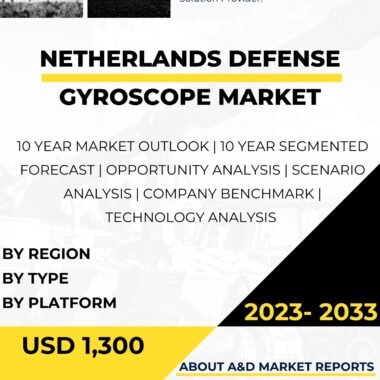Description
The China Defense Gyroscope Market is a critical sector within the country’s defense industry, encompassing the development, production, and deployment of gyroscope systems for military applications. Gyroscopes are essential components that provide stability, orientation, and navigation capabilities to a variety of defense systems, including aircraft, missiles, ships, and ground-based vehicles. China’s focus on enhancing its defense capabilities and achieving self-sufficiency in military technology has driven the growth and development of the Defense Gyroscope Market.
China has significantly increased its defense spending over the past decade, leading to substantial investments in its domestic defense industry. The country recognizes the importance of developing advanced military capabilities, including cutting-edge gyroscope systems. As a result, there has been a strong emphasis on research and development, as well as the establishment of advanced manufacturing facilities, to enhance indigenous gyroscope technologies.
One of the key drivers of the China Defense Gyroscope Market is the government’s push for technological self-sufficiency. China aims to reduce its dependence on foreign suppliers and enhance its domestic defense industrial base. To achieve this goal, significant investments have been made in research and development, leading to notable progress in the design and production of advanced gyroscope systems. Chinese defense companies have been actively working on the development of gyroscope systems to meet the specific requirements of their defense applications.
Furthermore, China’s growing military capabilities and its ambition to modernize its armed forces have necessitated the development of advanced gyroscope systems. The country’s defense systems require precise and reliable gyroscope technologies for stability control, navigation, targeting, and platform stabilization. Chinese defense companies have been actively engaged in developing and enhancing gyroscope systems to meet the demanding requirements of military applications.
Moreover, China benefits from a robust and well-established electronics and sensor technology industry, which facilitates the development and production of advanced gyroscope systems. The country possesses several state-owned and private companies with expertise in electronics and sensor engineering. These companies have the infrastructure, resources, and technical know-how to design, develop, and produce state-of-the-art gyroscope systems. The presence of a strong industrial base in electronics promotes collaboration and knowledge sharing, further boosting the growth of the Defense Gyroscope Market.
Additionally, China’s Defense Gyroscope Market has witnessed increasing international collaboration and exports. Chinese defense companies have actively sought partnerships with foreign gyroscope manufacturers to access advanced technologies and expertise. These collaborations enable technology transfer and knowledge exchange, enhancing China’s indigenous capabilities in gyroscope system development. Furthermore, the export of Chinese gyroscope systems to other countries contributes to the growth of the market, establishing China as a competitive player in the global defense gyroscope industry.
However, the China Defense Gyroscope Market also faces challenges. Quality and reliability are crucial concerns as Chinese defense companies strive to match the standards set by established international suppliers. While significant progress has been made, continuous investments in quality control and assurance processes are necessary to gain the trust of domestic and international customers.
Moreover, integration and interoperability of gyroscope systems remain important considerations. Defense systems often consist of a variety of sensors and navigation technologies, and ensuring seamless integration and interoperability of gyroscope systems is essential for optimal performance and mission success. Efforts are being made to develop standardized systems and protocols to facilitate interoperability and streamline integration across different defense platforms.
Furthermore, intellectual property rights (IPR) protection is an important consideration. To foster international collaborations and attract foreign customers, Chinese defense companies must demonstrate their commitment to IPR protection. Adhering to international standards and best practices regarding intellectual property rights is crucial for building long-term partnerships and ensuring sustainable growth in the global Defense Gyroscope Market.
In conclusion, the China Defense Gyroscope Market is witnessing steady growth and development. The government’s focus on technological self-sufficiency, combined with investments in research and development, has led to significant advancements in indigenous gyroscope systems. China’s growing military capabilities, well-established electronics and sensor technology industry, and international collaborations contribute to its position as a competitive player in the global defense gyroscope industry. Addressing quality control, promoting integration and interoperability, and ensuring intellectual property rights protection will be crucial for further growth and success in this dynamic sector.




